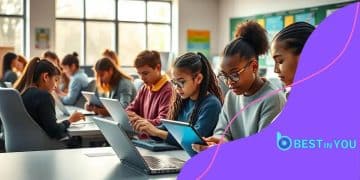Addressing teacher shortages through remote teaching platforms

Advertisements
Addressing teacher shortages through remote teaching platforms connects schools with qualified educators globally, enhances student learning flexibility, and promotes innovative teaching methods, although challenges such as technology access and engagement remain.
Addressing teacher shortages through remote teaching platforms presents an innovative approach to enhancing education. Imagine how students could connect with expert teachers worldwide, breaking geographic barriers and enriching learning experiences. Curious about how this could unfold? Let’s dive in.
Anúncios
Understanding the current teacher shortage
The problem of teacher shortages has become increasingly significant in our education system. Today, many schools struggle to find qualified teachers, which can affect student learning and overall school performance.
What Causes Teacher Shortages?
Several factors contribute to the teacher shortage crisis. For instance, many teachers leave the profession due to low salaries and challenging working conditions. This leads to fewer available educators in the classroom.
- Low wages and benefits
- High levels of job stress
- Lack of administrative support
- Burnout and early retirements
Another major issue is that not enough new teachers are entering the field. Many graduates opt for different careers due to the challenges associated with teaching. This trend is worrying as it creates a growing gap between teacher supply and demand.
Anúncios
Impact on Education
The impact of teacher shortages can be severe. Students may face larger class sizes, which can hinder their learning experience. Additionally, schools may resort to hiring less experienced or less qualified teachers, further compromising education quality.
Moreover, subjects like STEM (Science, Technology, Engineering, and Mathematics) are particularly hard hit. Schools need specialized teachers to provide students with the skills necessary for today’s job market. Without them, students may miss out on essential learning opportunities.
In conclusion, addressing the current teacher shortage requires immediate attention. By understanding its causes and effects, we can explore effective solutions that could secure a better educational future for our children.
Benefits of remote teaching for schools
Remote teaching offers several benefits for schools that can enhance the learning experience for students. With advances in technology, educators can innovate their teaching methods and reach students more effectively.
Flexibility in Learning
One of the most significant advantages of remote teaching is the flexibility it provides. Students can learn from different locations and at times that suit them best. This flexibility helps accommodate various learning styles and schedules, allowing students to engage with content in ways that work for them.
- Personalized learning experiences
- Access to a broader range of resources
- Ability to balance studies with other commitments
Moreover, remote teaching enables schools to connect with experienced educators beyond their local area. Schools can attract talented teachers who might not be able to relocate, greatly enhancing educational offerings.
Cost Efficiency
Implementing remote teaching can also reduce operational costs for schools. By minimizing the need for physical infrastructure and materials, schools can allocate resources to improve technology and training. This can lead to better educational outcomes for students.
Additionally, schools can save money on transportation and facility maintenance. With less need for traditional classrooms, resources can be redirected to enhance teachers’ skills and develop innovative curriculum materials.
As we explore the revolution of remote teaching, it’s important to consider how these benefits can positively impact both students and educators, creating a more effective and inclusive educational environment.
How remote platforms attract qualified teachers

Remote teaching platforms have become essential tools for attracting qualified teachers. These platforms provide benefits that make teaching more appealing and accessible for educators.
Wider Opportunities for Employment
One major way remote platforms attract teachers is by offering job opportunities beyond geographical constraints. Teachers can connect with schools around the world, allowing them to find positions that match their skills and interests.
- Access to international job markets
- Variety of teaching roles available
- Flexible working hours
Alongside job opportunities, these platforms often allow educators to showcase their qualifications and experiences in an engaging way. This can include submitting video lessons or interactive profiles that highlight their teaching style.
Supportive Community and Resources
Another attraction is the sense of community that remote teaching platforms offer. Many platforms provide access to a network of fellow educators, where teachers can share resources, ideas, and strategies. This support can be vital for both new and experienced teachers.
Furthermore, many remote platforms invest in professional development. Teachers can access workshops, training sessions, and resources that help them grow in their careers. This kind of investment in teachers makes remote platforms more appealing.
As the landscape of education evolves, understanding how remote platforms attract qualified teachers is crucial. By leveraging technology and fostering community, these platforms can continue to enhance the teaching profession.
Challenges of implementing remote teaching
Implementing remote teaching presents various challenges that schools and educators must navigate. While technology offers excellent opportunities, it can also create obstacles that need to be addressed.
Technology Barriers
One of the primary challenges is ensuring that all students have access to the necessary technology. Many students may lack reliable internet access or suitable devices for online learning. This digital divide can hinder their ability to participate fully in classes.
- Inconsistent internet connectivity
- Limited access to computers or tablets
- Software familiarity and usage issues
Moreover, teachers must be proficient in using various digital tools, which can require additional training. Schools need to invest time and resources to equip teachers with the skills they need for effective remote teaching.
Student Engagement
Another significant challenge is maintaining student engagement. Online environments can sometimes feel less personal and motivating compared to traditional classrooms. Teachers must be creative in fostering a sense of community and connection, making lessons interactive and engaging.
Additionally, some students may struggle with self-discipline while learning from home. Without the structured environment of a classroom, they might find it challenging to stay focused on their studies. This can lead to lower participation rates and academic performance.
Navigating the challenges of implementing remote teaching is essential for schools aiming to provide quality education. By addressing these obstacles head-on, educators can create a more effective and supportive online learning environment.
Future trends in remote education
The future of remote education holds exciting possibilities as technology continues to evolve. As schools adapt, we can expect significant changes that will enhance teaching and learning experiences.
Personalized Learning Experiences
One major trend is the move towards personalized learning. With the help of artificial intelligence, educational platforms can tailor lessons to meet individual student needs. This approach allows students to learn at their own pace and aligns with their learning styles.
- Adaptive learning technologies
- Customized lesson plans based on performance
- Increased student agency in their learning
As schools embrace these innovations, teachers can better support their students, ensuring that everyone receives the education they deserve.
Increased Collaboration
Another trend is enhanced collaboration among students and teachers. Remote education breaks down barriers, allowing learners from different backgrounds and locations to work together on projects. This collaboration fosters diverse perspectives and ideas.
Online tools like video conferencing and collaborative software help facilitate group work. Students can easily share resources and communicate effectively, enhancing their learning processes.
Looking ahead, the integration of virtual reality (VR) and augmented reality (AR) technologies in education shows great promise. These tools can create immersive learning environments, making subjects like science and history more engaging and interactive.
As educators continue to innovate, the landscape of remote education will become increasingly dynamic and effective, paving the way for future generations.
FAQ – Frequently Asked Questions about Addressing Teacher Shortages through Remote Teaching Platforms
What are the main benefits of remote teaching platforms?
Remote teaching platforms enable access to qualified teachers, provide flexibility in learning, and foster a collaborative learning environment.
How do remote platforms help with teacher shortages?
They connect schools with educators regardless of location, increasing the pool of available teaching talent.
What challenges do students face in remote education?
Students may struggle with technology access, engagement, and self-discipline, which can hinder their learning experience.
What future trends can we expect in remote education?
Expect personalized learning experiences, increased collaboration, and the integration of technologies like virtual and augmented reality.





